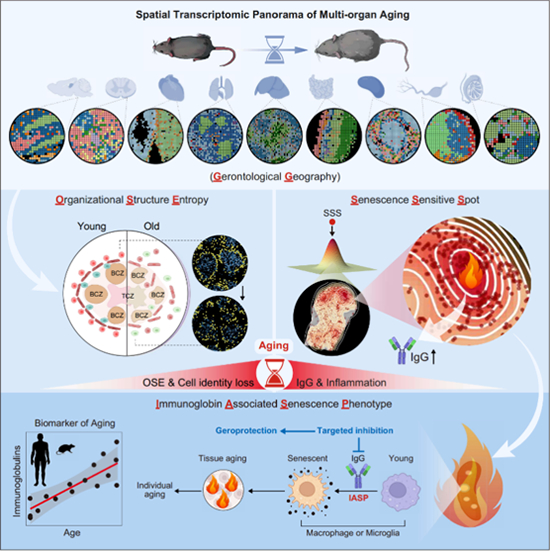

Spatial transcriptome landscape reveals immunoglobulin related aging phenotype
Under the support of the National Natural Science Foundation of China (Grant No.: 82125011, 82488301, 81921006), researcher Liu Guanghui from the Institute of Zoology, Chinese Academy of Sciences, researcher Gu Ying from the Institute of Life Sciences, researcher Zhang Weiqi from the Beijing Institute of Genomics, Chinese Academy of Sciences, and researcher Qu Jing from the Institute of Zoology, Chinese Academy of Sciences, have made progress in the research on immunoglobulin driven aging. The research findings, titled "Spatial Transcriptomic Landscape Unveils Immunoglobulin Associated Aging as a Hallmark of Aging," were published online on November 4, 2024 in the journal Cell. Paper link: https://doi.org/10.1016/j.cell.2024.10.019 .
Aging is a complex, heterogeneous, asynchronous, and nonlinear process. Over time, aging leads to uneven changes in the structure and characteristics of cells within tissues, which not only disrupts the molecular regulatory network within cells, but also profoundly affects the spatial distribution and interactions of cells within organs. At present, people's understanding of how aging triggers tissue and cell degeneration at the spatial level is still limited, and revealing the core driving forces of aging in a complex spatiotemporal context is an important challenge facing aging science research.
This study constructed the world's first high-precision pan organ aging spatial navigation map of nine mouse tissue organs - hippocampus, spinal cord, heart, lungs, liver, small intestine, spleen, lymph nodes, and testes - by finely analyzing millions of spatial loci. Genetic Geography (GG) revealed the distribution characteristics of over 70 cell types and found that tissue structure disorder and loss of cell identity are common features of multi organ aging. The research team further constructed a specific sensitive gene set for aging spatial location and identified key aging sensitive sites (SSS). Research has found that the entropy increase and loss of cell identity are more pronounced in the tissue structure near the SSS region. Cells expressing immunoglobulin related genes are located near the microenvironment centered on SSS, driving tissue aging. Further research has confirmed that IgG can directly cause aging of macrophages and microglia in humans and mice, and release inflammatory factors. Directly injecting IgG into young mice can also induce aging of multiple tissues and organs throughout the body. The team also developed an intervention strategy based on antisense oligonucleotides (ASO), which effectively reduced the IgG content in mouse tissues and delayed multi organ aging (Figure).
This study not only accurately located the core areas of aging in multiple organs, but also found that the accumulation of immunoglobulin is a key feature and driving factor of aging. This discovery provides a new scientific basis for a deeper understanding of the mechanisms, warnings, and interventions of aging.